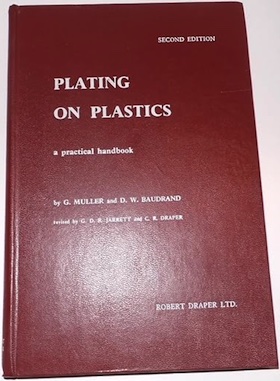
-----
Adhesion Problem, Electroless Silver Plating on Polyamide
Q. Dear all,
We are a company in Sweden that have developed an autocatalytic silver plating bath. We have recently embarked on two projects which aim is to plate silver on polyamide (nylon). We have come up with a couple of possible solutions for getting the silver on the polyamide, but we want to explore more options. We get the best adhesion with our silver on copper or another seed layer of silver. I would be grateful for any help or any suggestions on how to deal with this. Easy process-setup is a clear advantage.
- Gothenburg, Sweden
2005
|
A. In order to achieve adhesion to plastic, micro porosity must be created in the basis material. In the case of polyamide, etching in 10% sodium hydroxide [affil link] will create the micro porosity. The etch step is followed by thorough rinsing then dilute acid e.g. 3% HCL, rinse, apply the seed layer,then electroless plate. the Polyamide will have a soft surface. If your product is a flat sheet, pass it through rubber rollers. If it is irregular shaped, cure it with low temperature baking.  Don Baudrand Consultant - Poulsbo, Washington (Don is co-author of "Plating on Plastics" [on Amazon or AbeBooks affil links] and "Plating ABS Plastics" [on Amazon or eBay or AbeBooks affil links]) 2005 A. Polyamides are notoriously difficult to successfully coat with aqueous electroless metal. This is because most of them are very hygroscopic and swell significantly amount when saturated in water. One of the most common nylons is type 66, although there is a whole range of possible combinations. The only one that may be suitable is Nylon 12 which is the least swellable in water. The nylon will need to be etched and activated using a suitable process that can be found in most "Plating on Plastics" text books. Alternatively, you can try vacuum deposition, but you may need to keep the nylon cooled to prevent it melting in the vacuum chamber.  Trevor Crichton R&D practical scientist Chesham, Bucks, UK 2005 |
Electroless silver plating on polyurethane
Q. Dear sir ,
I am doing research on electroless deposition of silver on polyurethane.
Can you tell me the proper pretreatment and bath composition for this?
kiit university bhubaneswar - bhubaneswar odisha India
March 20, 2015
Q. Dear Sir,
Can your suggest please any "Plating on Plastics" text books with polyamides plating?
Thanks
- Israel, Haifa
September 11, 2016
Q. We have received to be analyzed a polyamide Car handle before plating due is suffering delamination after plating,. these delamination issue is located close to the injection region.
I have done some measurements, and I founded that on the PA surface there is a significant silicone PDMS on the surface.
I have checked by XPS, that the failure issue is not related to bad dispersed fillers on the surface, because the composition is more or less similar close and far to the adhesion failure region.
Together this, in the failure region tehre is a dark pit, whichI have analyzed too. The pit dark in colotr from brown to black, is organic with a great signal of PDMS.
Could be the silicone the platting delamination reason_
Thanks in advance
- Vigo, Pontevedra, Spain
October 18, 2018
Q, A, or Comment on THIS thread -or- Start a NEW Thread
